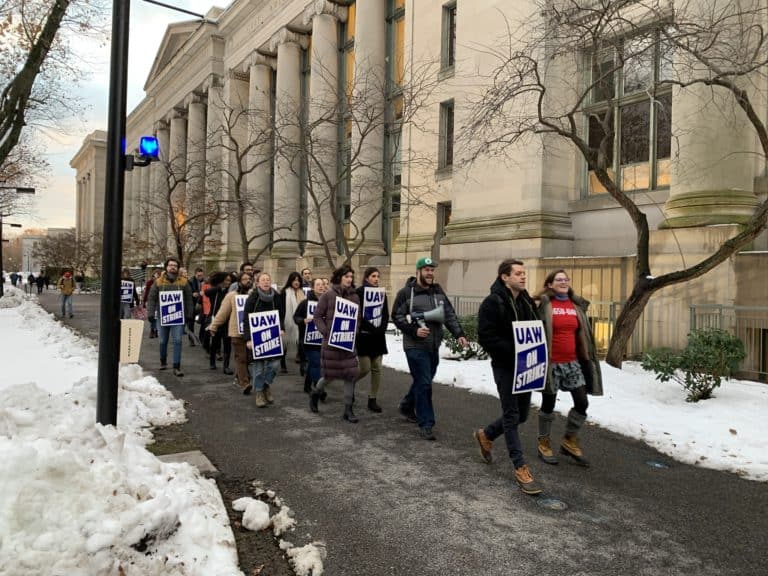“Gig economy” or “online platform” companies that provide personal labor services—Uber, Lyft, TaskRabbit, Handy, Instacart, Grubhub, and others—challenge American law’s system for classifying workers as “employees” or “independent contractors, As I explain in my new article “Workers, Benefits, and Protection in the U.S. Gig Economy,” employees are protected by a legally imposed workplace social compact. Independent contractors are not. Yet, the structure of online platforms companies’ relationships with their workers forces their workers into a gray area between the two statuses. As one U.S. federal judge described online platform workers, they “don’t seem much like employees,” but also “don’t seem much like independent contractors either.” Choosing a legal status, he said, is like being “handed a square peg and asked to choose between two round holes… Some factors point in one direction, some point in the other, and some are ambiguous.”
American law offers no broadly applicable rule for resolving these cases. As a result, confused and ambiguous legal factors allow adjudicators to produce widely disparate results in cases presenting essentially the same issue involving the same or similar workers, sometimes in different forums and sometimes in the same forums. Two judges recently issued the first final merits decisions about the classification of online platform workers in a U.S. district court. Both held the workers are independent contractors. Thereafter, California’s Supreme Court, in a case about workers outside the online platform economy, changed its worker classification test in a way that will almost certainly result in all or most California online platform workers being classified as employees. Most states’ administrative and regulatory bodies have treated these workers as employees, although a New York appellate court held recently they were independent contractors under that state’s unemployment insurance law. No federal agency has issued a final decision or lasting guidance.
Simply, confusion reigns. No employer, worker, or union can predict confidently how cases will be decided. Adjudicative decisions seem to justify pre-determined results. There are few reliable guardrails against regulatory arbitrage by employers. Perhaps most important, workers who should benefit from the workplace social compact are being wrongfully excluded. My article proposes how we might solve this problem.
The problem extends beyond the online platform economy. As my co-author Alan Krueger and I explained in our 2015 paper, there are workers outside the online platform economy—like some taxi drivers—in triangular work relationships like those involving online platform workers. But the problem also extends to many independent contractors.
Understanding the breadth of the problem requires finding its core. In my view, that’s workers’ lack of individual bargaining power. We have an American workplace social compact because employees do not have sufficient individual bargaining power in their relationships with employers to produce the outcomes required by the workplace social compact. Employees relinquish control over their work hours and the particulars of work assignments to their employers. They withdraw from the labor market. Thus, during the period of the employment relationship, employers have characteristics of monopsonists in the purchase of their own employees’ labor services, with the attendant bargaining strength in their dealings with employees. Plainly, employees can apply for other jobs on their own time, but there are transaction costs and risks associated with quitting and joining a new employer’s workforce. As those costs and risks climb, the bargaining power of the employer increases, as well.
In the workplace, employees gain only the experience, skills, and knowledge that are instrumental to the employer. They are not free—at least during work hours—to plan or invest in human capital acquisition to strengthen their own bargaining position in the present or the future. Similarly, employees generally do not invest in work tools or equipment which could be used to perform other jobs and, therefore, strengthen bargaining power. Depending upon the occupation, the lack of capital and capital investment can be another barrier to transitioning to a new work arrangement. Without ready alternatives to their current employer, employees’ individual bargaining power weakens.
In return for relinquishing bargaining power, the law intervenes on employees’ behalf to impose certain minimum standards: minimum wage and an overtime pay premium; protection from discrimination; a safe and healthy workplace; unpaid leave for family and medical purposes in many instances; employers’ full or partial contributions to payroll taxes that make workers eligible for unemployment insurance, Social Security retirement and disability benefits, and Medicare; workers compensation insurance; the right to organize and bargain collectively; health insurance or (a tax penalty to pay for public subsidies); an extensive set of requirements for retirement savings plan. These benefits and protections constitute the American workplace social compact.
The goal of the legal worker classification system is not to exclude independent contractors from these benefits and protections. Rather, independent contractors are presumed to have sufficient individual bargaining power in their dealings with contracting partners to ward off those undesirable outcomes, or use their freedom in the market to evade them. Yet, this presumption proves to be wrong for many independent contractors. As I explain in my article in greater detail, many independent contractors closely resemble employees with respect to their lack of individual bargaining power. As a result, I argue, it is time to construct a new set of legal worker classification rules and new ways to distribute the compact’s benefits and protections.
I begin with values or principles. In policy analysis circles, these are called “selection criteria” because they are used to assess and choose among policy options. In the article, I nominate five selection criteria:
- Social Compact Outcomes: Whether the policy promotes the outcomes codified in the American workplace social compact for as many workers as practicable and appropriate.
- Efficiency: Three forms: (a) many labor and employment laws increase market efficiency; so, broader application would generally produce improved efficiency; (b) unnecessary litigation costs are inefficient; and (c) transaction costs.
- Innovation and entrepreneurship: Given the relationship between job creation, economic growth, and workers’ welfare, and the benefits many workers derive from their relationships with some online platform companies, promotion of innovation and entrepreneurship matters.
- Regulatory arbitrage: Market competitions should be won by superior goods and services, lower prices, or greater convenience, not loophole-seeking lawyers or exploitation of a lack of ethics or law enforcement.
- Horizontal equity: Like cases should be treated alike.
Then, I offer and analyze six policy options:
- Do nothing
- Establish a default rule that all workers are employees unless the employer rebuts a clearly articulated presumption (California’s Supreme Court adopted one version of this option, but I propose another focused on individual bargaining power)
- Declare all online platform (and similarly situated) workers are “employees”
- Declare all online platform workers are “independent contractors” (some states are enacting laws that achieve this result in part of full)
- Require a modified set of company-provided benefits and protections tailored to online platform (and similar) workers (the Harris-Krueger proposal offers one version of this option, while so-called “portable benefits” proposals offer a second version)
- Establish/expand public benefits system to provide benefits and protections to all online platform (and similar) workers
My analysis in the article leads me, perhaps predictably, to endorse my own work: the proposal contained in the 2015 Harris-Krueger paper best satisfies the selection criteria. However, other proposals, especially the portable benefits proposals, the default rule, and the public benefits system, are well worth considering.
Others may weigh the selection criteria differently, or add or subtract criteria, in a way that would produce different results. Regardless, it is clear that doing nothing is the worst option of all.










Daily News & Commentary
Start your day with our roundup of the latest labor developments. See all
November 28
Lawsuit against EEOC for failure to investigate disparate-impact claims dismissed; DHS to end TPS for Haiti; Appeal of Cemex decision in Ninth Circuit may soon resume
November 27
Amazon wins preliminary injunction against New York’s private sector bargaining law; ALJs resume decisions; and the CFPB intends to make unilateral changes without bargaining.
November 26
In today’s news and commentary, NLRB lawyers urge the 3rd Circuit to follow recent district court cases that declined to enjoin Board proceedings; the percentage of unemployed Americans with a college degree reaches its highest level since tracking began in 1992; and a member of the House proposes a bill that would require secret ballot […]
November 25
In today’s news and commentary, OSHA fines Taylor Foods, Santa Fe raises their living wage, and a date is set for a Senate committee to consider Trump’s NLRB nominee. OSHA has issued an approximately $1.1 million dollar fine to Taylor Farms New Jersey, a subsidiary of Taylor Fresh Foods, after identifying repeated and serious safety […]
November 24
Labor leaders criticize tariffs; White House cancels jobs report; and student organizers launch chaperone program for noncitizens.
November 23
Workers at the Southeastern Pennsylvania Transportation Authority vote to authorize a strike; Washington State legislators consider a bill empowering public employees to bargain over workplace AI implementation; and University of California workers engage in a two-day strike.